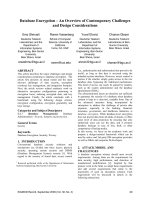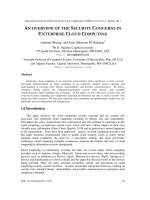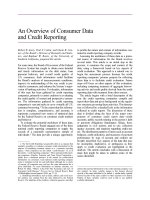An overview of computers and programming language
Bạn đang xem bản rút gọn của tài liệu. Xem và tải ngay bản đầy đủ của tài liệu tại đây (137.98 KB, 12 trang )
C++ Programming: From Problem
Analysis to Program Design, Fifth Edition
An Overview of Computers and
Programming Languages
Updated by:
Malak Abdullah
Updated by:
Malak Abdullah
The Evolution of Programming Languages
(cont'd.)
High-level languages include Basic, FORTRAN,
COBOL, Pascal, C, C++, C#, and Java
Compiler: translates a program written in a high-
level language machine language
C++ Programming: From Problem Analysis to Program Design, Fifth Edition 2
Updated by:
Malak Abdullah
Processing a C++ Program
#include <iostream>
using namespace std;
int main()
{
cout << "My first C++ program." << endl;
return 0;
}
Sample Run:
My first C++ program.
C++ Programming: From Problem Analysis to Program Design, Fifth Edition 3
Updated by:
Malak Abdullah
Processing a C++ Program (cont'd.)
To execute a C++ program:
Use an editor to create a source program in C++
Preprocessor directives begin with # and are
processed by a the preprocessor
Use the compiler to:
Check that the program obeys the rules
Translate into machine language (object program)
C++ Programming: From Problem Analysis to Program Design, Fifth Edition 4
Updated by:
Malak Abdullah
Processing a C++ Program (cont'd.)
To execute a C++ program (cont'd.):
Linker:
Combines object program with other programs provided
by the SDK to create executable code
Loader:
Loads executable program into main memory
The last step is to execute the program
C++ Programming: From Problem Analysis to Program Design, Fifth Edition 5
Updated by:
Malak Abdullah
Processing a C++ Program (cont'd.)
C++ Programming: From Problem Analysis to Program Design, Fifth Edition 6
Updated by:
Malak Abdullah
Programming with the Problem Analysis–
Coding–Execution Cycle
Programming is a process of problem solving
One problem-solving technique:
Analyze the problem
Outline the problem requirements
Design steps (algorithm) to solve the problem
Algorithm:
Step-by-step problem-solving process
Solution achieved in finite amount of time
C++ Programming: From Problem Analysis to Program Design, Fifth Edition 7
Updated by:
Malak Abdullah
The Problem Analysis–Coding–Execution
Cycle (cont’d.)
C++ Programming: From Problem Analysis to Program Design, Fifth Edition 8
Updated by:
Malak Abdullah
The Problem Analysis–Coding–Execution
Cycle (cont'd.)
Run code through compiler
If compiler generates errors
Look at code and remove errors
Run code again through compiler
If there are no syntax errors
Compiler generates equivalent machine code
Linker links machine code with system resources
C++ Programming: From Problem Analysis to Program Design, Fifth Edition 9
Updated by:
Malak Abdullah
The Problem Analysis–Coding–Execution
Cycle (cont'd.)
Once compiled and linked, loader can place
program into main memory for execution
The final step is to execute the program
Compiler guarantees that the program follows the
rules of the language
Does not guarantee that the program will run
correctly
C++ Programming: From Problem Analysis to Program Design, Fifth Edition 10
Updated by:
Malak Abdullah
Example 1-1
Design an algorithm to find the perimeter and area
of a rectangle
The perimeter and area of the rectangle are given
by the following formulas:
perimeter = 2 * (length + width)
area = length * width
C++ Programming: From Problem Analysis to Program Design, Fifth Edition 11
Updated by:
Malak Abdullah
Example 1-1 (cont'd.)
Algorithm:
Get length of the rectangle
Get width of the rectangle
Find the perimeter using the following equation:
perimeter = 2 * (length + width)
Find the area using the following equation:
area = length * width
C++ Programming: From Problem Analysis to Program Design, Fifth Edition 12









